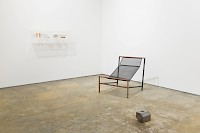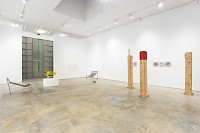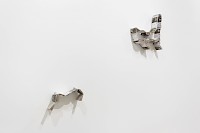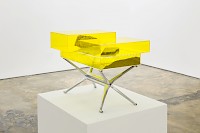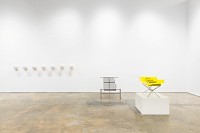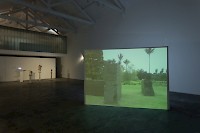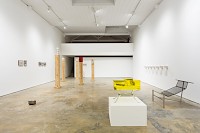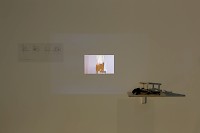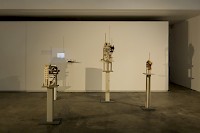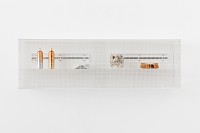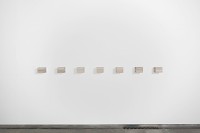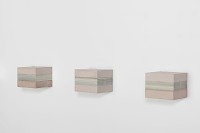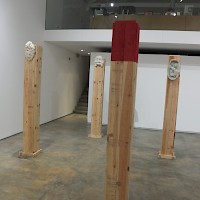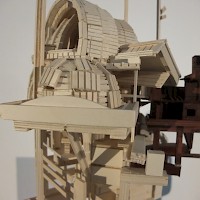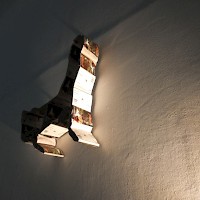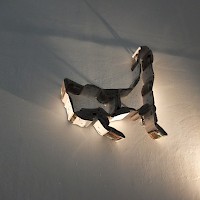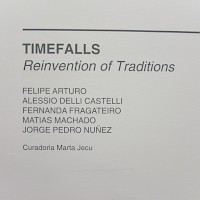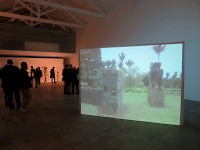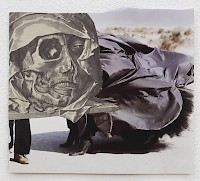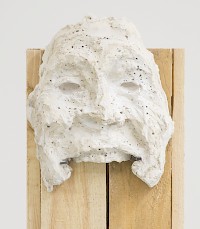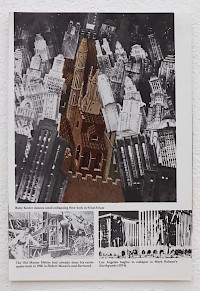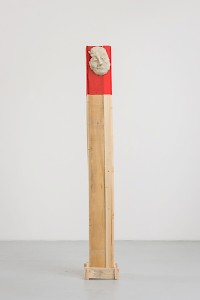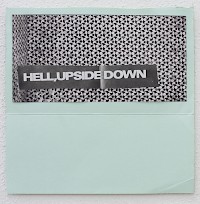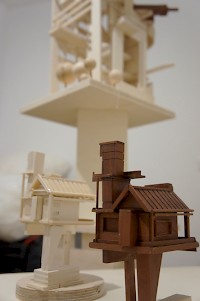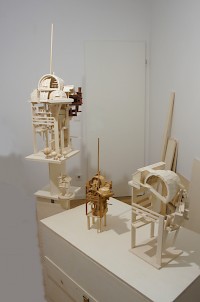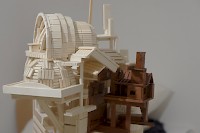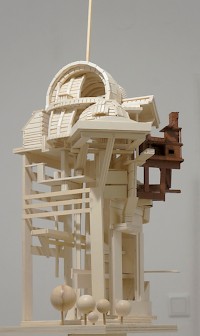Exhibition
TIMEFALLS
Reinvention of Tradititions
November 2016
Galeria Baginski, Lisboa
Artists: Felipe Arturo
Matias Machado
Alessio delli Castelli
Fernanda Fragateiro
Jorge Pedro Núñez
Curator: Marta Jecu
TIMEFALLS
Reinventions of Tradition
'Everything passes in time but time itself!' proclaims on a quite somber tone Eduardo Cadava1. For him, the present is not simply the present, but a result of the multitude of images that form it "now" and that might come from alien spaces and historical moments. Any image is for him always the image of another time.
His enchanting book Lapsus Imaginis: The Image in Ruins practically explains the reason why an image can never be regarded as being complete and constituted. What Cadava calls the lapsus of the image (lat. for lapse, slip, missing) reveals the inherent condition of the image to be perpetual in the process of its constitution. For him the image exists through the dialectical relationship between a past and a present in a historical and imagistic sense. No image is for him simply itself.
'The image is always at the same time an image of ruin, an image about the ruin of the image, about the ruin of the image's capacity to show, to represent, to address and evoke the persons, events, things, truths, histories, lives and deaths to which it would refer. Nevertheless, what makes the image an image is its capacity to bear the traces of what it cannot show, to go on, in the face of this loss and ruin, to suggest and gesture toward its potential for speaking.' (Cadava 2001: 36).
This text was an inspiration for the TIMEFALLS exhibition, as Cadava’s idea that the past is essentially bound not to be recovered, as we experience it in terms of loss and ruin. But Cadava opens this vision and inspires for a reading of the past that overpasses the reiteration and enactment of the condition of loss and displacement. He advocates for a learning from the irretrievable images of the past by internalizing that the ruins of history and their images are a constitutive part of ourselves. The image is bearing several memories at once. For him the image is therefor never closed.
This exhibition is dedicated to the recurrent necessity of contemporary artists to re-load the past, future and present into ‘the image’ and therefore to re-cast 'traditions'. We can think in this context also about the concept of the “Reinvention of Tradition” - a pluri-valent notion which has been invested with various content in cultural analysis.
Very often tradition has been reinvented in order to legitimize a certain ideology, discourse or political attitude. The famous anthropological theory of E. J. Hobsbawm and T. O. Ranger from 1983 orginary launched the term. Here we find examples of how "traditions" which "appear or claim to be old are often quite recent in origin and sometimes invented." Old traditions are often "re-invented", but there are also cases in which new traditions are being "started".
Many of the work included in this show, deal with various forms in which traditions have been actually recreated. They also imply the political background of such appropriations. E. J. Hobsbawm and T. O. Ranger relate this phenomenon also to the modern development of the nation and of nationalism, creating a national identity promoting national unity based on a certain cultural tradition, which has been in fact invented based on disparate elements assembled. These invented traditions are often involved for legitimising certain institutions or cultural practices. In many of the works exhibited in this show we find allusions to the art of the Modernism and that of the Renaissance, but these are never innocent forms, as they carry with them cultural wars, the heritage of colonialism, or present economic relations of power – especially in regard to Latin American and European connections.
The exhibition travels between forms which show how the history of art has been reinvented, to others that show how historical themes transport socio-economic and political aspects. These run like deeper currents through the works presented here and reveal often conflictual, un-resolved historic themes.
The work of the three Latin American artists (Matias Machado – Argentina, Felipe Arturo – Colombia, Jorge Pedro Nunez – Venezuela) touch on questions of display and transmission of cultural content from these three cultural contexts into an European context. They document the alterations experienced by the artists' own traditions of thought, cultural habits, visions, images and their imaginary connected to their cultures.
But they also manifest tensed economic relations between Latin America and Europe. We can find allusions to cultural forms since the end of the 19th century, the Latin American modernism and its reception in Europe, but also to today's large scale biennials' scaffolding of information, to architectural complexes and fairs. The artists show how these models of representations impose economic contingencies.
Felipe Arturo's video 'Earthfalls' inspires the title of the exhibition and occupies a prominent position in the exhibition, as a quintessence of its concept. It catches the perpetual and internal movement, that is present in the other work too: pillars of our civilization seem now archaeological pieces in an indefinite space, which is cultural and natural at the same time. Felipe Arturo is formed as an architect and works on urbanism, architecture and politics in Colombia, drawing back to history and to lingering postcolonial relations. Arturo’s work talks about the traces of Colombian history that we can still identify in vernacular architecture and also about techniques of construction which resulted from the complex processes of de-colonization.
'Vorágine Materia Prima' a series of book-installations placed on the gallery wall, departs from the novel La Vorágine (1924), by José Eustacio Rivera, both as conceptual content and physical material of the work (the books themselves). The novel narrates the troubled journey of a young couple in Colombia, escaping from the centralist and conservative society of Bogotá to the southern lands of the tropical forest. The couple is finally enslaved in the rubber camps of the Putumayo region.
At the same time, we are reminded of the natural form of any book: fiber. Its apparition and propagation was based often on exploitation connected to rubber industry, injustice, and even slavery. Interweaving the paper from one book with another creates parasitic structures, which recall historic forms of economic parasitism and recent propagation of economic dependency.
Matias Machado's conjoint of three models and a video ('On Disappearance of Spaces', 2016) describe a ruin – the reminiscences of a space's burning process – and are revealing a sort of tautological space that reproduces itself in a vicious circle. A video shows how this lost space is engulfed by a larger one. For Machado this is a reminder of the way in which effacing a space means eradicating its past, present and future possible forms – and his models combine architectural forms of different cultural periods. Therefore its history of development, its images and singularity are annihilated and disabled – a process without return. This is precisely the point in which Machado starts his enquiry. This dead point is for him a space for a possibility, he proposes an essay in this point of no return. This process has for him political ramifications, as it follows the dynamics of destruction and disappearance of cultural space. His works ultimately reproduce architecturally constructions of power and debate on the rights that memory are given in the reconstruction of history.
Alessio delli Castelli is preoccupied with historic artistic forms and especially with paradigmatic monuments of the Italian Renaissance, which he is symbolically transforming into the format 'model'. Specifically he concentrates on the power of Renaissance’s paradigms of building techniques, scaffolding, perspective, geometrisation, portraiture or the reconsideration of the Antiquity, like in the pillar masks which populate the exhibition. These presences emerging from the interstices of the gallery's space, seem to have descended from history.
His work materialises 'tradition' into unique, exemplary, exceptional 'precious objects', collages, drawings or symbolic figures. These fuse the present architecture (which houses this exhibition) with older patterns and memories. Delli Castelli's process of reflecting on the 'classicizing of representation' stays at the core of this exhibition.
Fernanda Fragateiro's series of works traces back the subtlety that modernist forms take in the course of their transformations and the precision with which form is adapted to a shifting conceptual content. Her work is infused with thorough research and dives into specific historic contexts related to Modernism, following characters like Mies van der Rohe and Lilly Reich and the epoch's understanding of notions of design or object-hood in relation to gender issues. Her pieces in this show transmit the power of the 'differentiation' that is developed during the reiteration of cultural forms. Her pieces seem to encapsulate not the aesthetic of historic forms, but rather their transmission. During this transfer, archival material is invested with a new creative potential and produces the 'new.'
In his practice Jorge Pedro Núñez is connecting historical forms developed at the beginning of the 20th century – in modernism, to daily events that he is personally witnessing or to social and historic contexts that he considers to be part of his own identity – as an analytic method. The installation plays with the stereotypes of the «modernist living room» and modern comfort. It performs short circuits between “high culture” and “popular culture.” While focusing on the revision of historical and modern forms, he is connecting to aspects of Latin American culture: the absorption of modernism in Latin America, their echo in the media connected to political aspects, examining specific condition in which art gains a social and political status. He alludes also to the social position of the 'artistic creator' and to the reception of artworks related to this specific context. In this installation we find references to Latin American brutalist architecture, but also to European arte povera. Steel, copper, plexiglass, rests of architecture, marble, cement, burnt motor oil, packaging for the cosmetic industry open to new applications and readings. The installation becomes a sort of landscape of forms caught between ruins and a future construction.
Marta Jecu
1 Cadava, E. (2001), 'Lapsus Imaginis: The Image in Ruins', in OCTOBER 96, Spring 2001, October Magazine Ltd. and Massachusetts Institute of Technology, pp. 35-60
